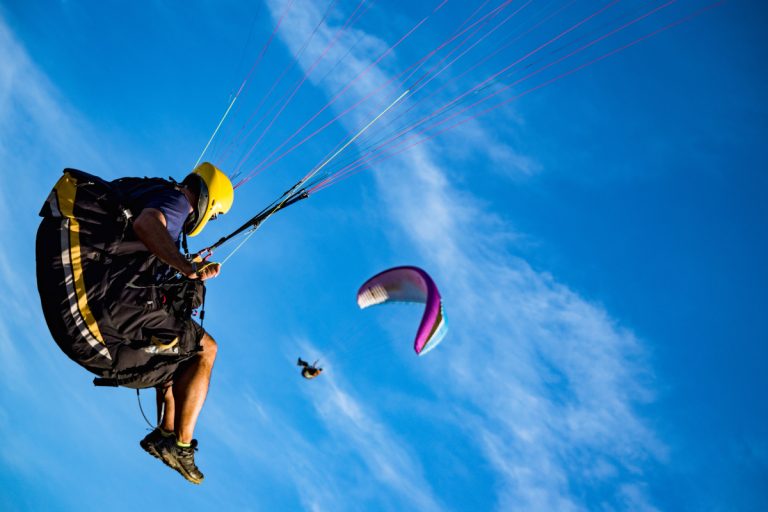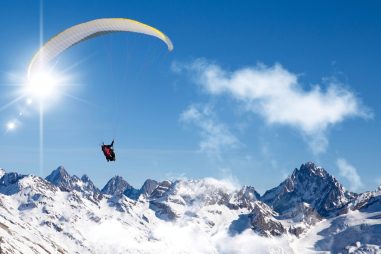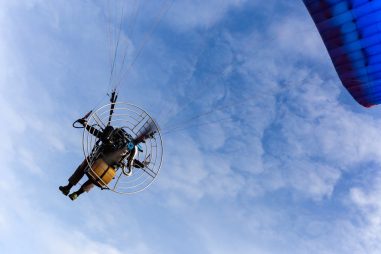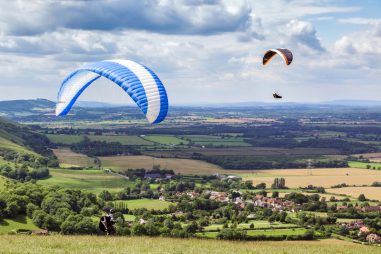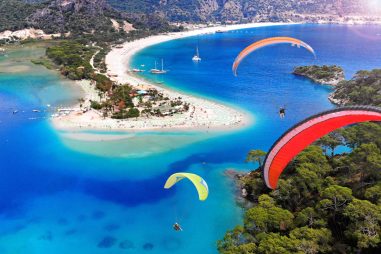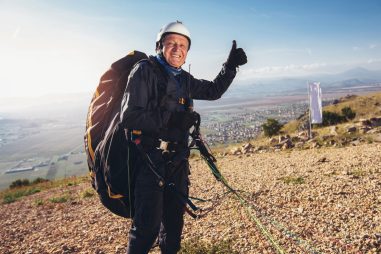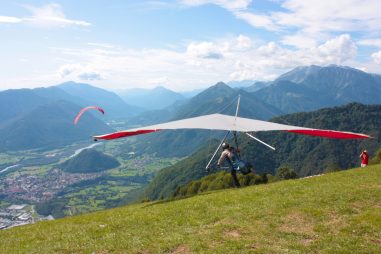Mountain regions are the most suitable for paragliding. This is because they have the best wind currents that offer long-distance flight. You will not need a license for paragliding, but you are required to train with a professional before attempting to fly solo.
What Is Paragliding?
Paragliding is an extreme aerial sport most popular in Europe. The pilot sits on a harness connected to a large curved inflatable wing. It is motorless, and the pilot launches by obtaining a lift. You control the paraglider by weight shifting and making use of breaks. Paragliding enthusiasts call it the simplest form of human flight.
Paragliding is a sport that can be recreational and competitive. The current record for world distance paragliding is 588.27 kilometers (366 miles). It is set by Marcelo Prieto, Rafael Saladini, and Rafael de Moraes Barros. The highest altitude achieved in the sport is an astounding 29,000 feet (8840 meters) by Ewa Wisnierska.
What Do You Do in Paragliding?
Paragliding significantly depends on the wind current. The curvature of the canopy or sail allows you to glide smoothly with the air over long distances and high altitudes. Rigging cords, known as lines, support the harness and other underside areas of the wing that allow for control. A pilot sits on the chair with a harness and takes off either through a forward launch, reverse launch, or towed launch.
As a beginner, you will start with tandem paragliding, where you will be with an expert pilot to teach the basics. There is a Student Paragliding Rating for a novice where you will need to achieve a P2 rating before you can paraglide on your own.
What Are Different Ways to Launch a Paraglider?
There are different ways to launch a paraglider based on your preference and current weather conditions. These are the forward launch, reverse launch, and towed launch. Read through the guidelines below to understand how to do them.
- Forward Launch: It is the easiest and most popular way of launching where you run forward with the wings behind you. It is most suitable for higher ground.
- Reverse Launch: It is another method that you can use to inspect the position of your canopy and that the lines are not tangled. Again, it is most fitting for powerful winds in high altitudes. You do this by running facing the wing, then turning around to launch the glider.
- Towed Launch: This method involves either a car or a boat helping you launch from the ground and releasing you when you reach the right altitude. Again, this type of launch requires separate training.
These types of launches will depend on your preference and the pros and cons. For instance, a forward launch is easy, but it entails a risk where you can’t check if your wing is in the correct place. A reverse launch can solve that, but it requires skill to change position. A towed launch, on the other hand, requires separate training altogether.
What Makes Paragliding Interesting and Unique?
Paragliding provides the rawest experience of flying. Most enthusiasts find this experience peaceful and leave them in awe of the beautiful sceneries around them. The thrill it offers is so enjoyable that most find this sport very addicting. Here are some more reasons why paragliding is an amusing and unique sport.
- You can cover hundreds of kilometers in paragliding: A skilled pilot can fly over an entire country. The Brazilian team who set the record for world distance paragliding in October 2019 went on a distance of 588.27 kilometers (366 miles) in eleven hours.
- Paragliding is safe: You may probably think that suspension at high altitudes is dangerous, but paragliding is one of the safest aerial sports. At least 30 lines hold your weight, and there is a reserve parachute for emergency situations. Of course, your safety also relies on correct analysis of the weather.
- Paragliding provides positive benefits for your physical and mental well-being: For example, it helps reduce stress, boosts self-confidence, and improves balance and posture.
- Paragliding enthusiasts control gliders with hand brakes: You can steer and adjust your speed while gliding through the air.
- There is no vertigo when flying: You may be feeling conscious if you are high above the ground, but it disappears when paragliding.
- Paragliding supports wheelchairs: Yes, you can use your wheelchair and connect it to the glider. Anyone with a physical disability who went through training can still paraglide.
- Paragliding relies heavily on the wind: It is the wind that will propel you. With good air condition and the right altitude, you can cover vast distances.
- Breathtaking views: Paragliding enthusiasts have the front row seat for the most beautiful sights.
- Paragliding helps shift perspective: As you glide through the wind, you’ll realize how big the world is and how small you and your problems are, changing your perspective positively.
- Paragliding is easier than it seems: This sport is slow, and maneuvering your glider is uncomplicated. However, with proper training, you’ll realize that you have more control over the sport than how it may generally seem.
NASA helped design the paraglider and gave the sport its name. It’s unique and fascinating on its own, making it one of the best aerial sports out there.
Is Paragliding Fun?
The answer is yes, paragliding is fun! It is one of the most thrilling aerial sports. You can even increase the challenge and go further up as you master the basic principles and maneuver skillfully in very high altitudes. Also, believe it or not, paragliding has astonishing mental health benefits. It relieves stress and shifts your perspective to a more positive light.
The ability to fly gives your mind and body an adrenaline rush and increases your energy and consciousness. It also gives you a feeling of being set free, helps conquer your fears, and makes you see the world around you from a different frame of mind.
How Does It Feel While Paragliding?
Most first-timers describe their paragliding experience as one of the best things they’ve ever done. The initial fear disappears once you witness the delightful views. The adrenaline rush you get from flying high above the sky leads to paragliding enthusiasts wanting more.
There is also a certain calmness that you can only find in paragliding. There is nothing but the sound of the wind engulfing you. Most enthusiasts describe paragliding as a spiritual and humbling experience.
What Does a Paraglider Look Like?
A paraglider is a noninflatable wing designed with the aerodynamic ability to fly. It is motorless, curved shaped, and made of two layers sewn together with a gap to allow air to enter the cells. Its material is tear-proof and tough ripstop nylon fabric. In between each rib are ‘cells’ that work to trap air and help inflate the wing for gliding.
Parts of a Paraglider:
- Wing: Called a canopy and is elliptical in shape to keep you airborne.
- Lines and Risers: These connect to the harness to allow for support, speed, and control of the direction of the flight.
- Harness: It envelops the body to keep it secure. It is comfortable and allows freedom of movement.
The paraglider wing supports the harness with at least 30 lines, fully supporting your body weight. Your paraglider may last based on the number of use and maintenance, up to 4 years, or 300 hours of paragliding.
What Shape Is a Paraglider?
A paraglider is elliptical in shape to have the aerodynamic ability to fly. A parachute is not the same as a paraglider, as the latter has the design to fly consistently. The wing has a leaning edge that allows air to enter the cells, which then inflates and then helps drift through wind.
A paraglider is inflatable, making it easy to bring when you go hiking. It also has a strong fabric and is tear-proof. In addition, it is sturdy and has four to five rows of lines that help you receive full support as you control your speed and direction.
Is a Paraglider an Aircraft?
A paraglider is an aircraft that is motorless, free-flying, and foot-launched. There are many accessible locations for paragliding, but not all places are suited for this sport. You also won’t need a pilot license to do paragliding, but it is necessary that you undergo proper training if you wish to learn it.
If you are going for the first time, it is recommended you go on tandem paragliding. Many paragliding schools offer paragliding courses if you’re thinking of flying solo. The minimum age to learn paragliding can vary from 16 to 18 years old in each country.
Is a Paraglider an Ultralight?
There is an Ultralight Paramotor available for paragliding. It is a motor that you wear on your back. The purpose is to help you launch and fly in the air. It is easy to travel and requires no assistance. You also don’t need to have a license to fly with one.
The paramotor is best suited for any pilot weighing less than 220lbs (100 kg) or less. A few restrictions when flying with one is that you can’t carry passengers with you, and your paraglider can’t go too fast.
How Does a Paraglider Work?
A paraglider has a ‘v’ or an elliptical shape that helps it remain airborne. It has two layers of fabric sewn together with a gap to help trap air and inflate the wing for flying. The underside of the paraglider has several lines to help when applying the brake, control, and speed. The risers are also lines that assist you in suspending below the wing.
There is a reserve parachute available in the event that the wing deflates because of an unexpected weather change. It can open quickly to ensure safety.
How Does a Paraglider Fly?
A paraglider works with airflow to create lift. There are three ways to stay aloft. One is through warm air masses called thermals, another is through a ridge lift, and the other is the weather wind called wave lift. The wind is an essential factor in paragliding as it helps you stay in the air and fly for a long time.
A paraglider has a leaning edge that allows air to enter the cells. It keeps the glider from deflating and ensures that you stay afloat.
What Force Is in Paragliding?
Using the science of aerodynamics, the shape of the paraglider helps create the relevant wind that generates the force that makes it possible for you to sustain the flight. The glider is more efficient if it produces more lift and less drag. To understand the different forces, read through the guidelines below.
- Lift: You will notice that a paraglider is ultralight. It is because the wing must be lighter in order to generate lift. The shape of the wing makes the airflow over the top faster than under the bottom. As a result, there is less pressure on top of the wing, giving it a lift.
- Drag: Drag is a force that pulls back or slows your forward motion.
It is important to note that your angle of attack matters when paragliding. It is the angle between the direction of the airflow and the paraglider. A high-angle attack may result in a stall. It is dangerous and difficult to control because the fall is fast.
How Does Air Help in Paragliding?
Air is a principal component in paragliding. It will help determine the speed and the duration of your flight. Understanding the different rising air is adamant in optimizing the flight and staying within the right weather conditions. Here are the different types of rising air.
- Thermals: It is hot air that rises from the ground. It is why most ascents are best in the summer. You can find thermal columns near areas like asphalt or dark rocky terrain.
- Ridge lift: It is a wind that blows against mountains that move upward, forming an uplift. It can last for miles along the mountain chain.
- Wave lift: Similar to a ridge lift, it blows against the mountains. The difference is that the uplift comes downwind and can go much higher than the mountain peak. It is usually because of strong winds in the upper atmosphere.
Recognizing the different types of rising air will help you make the most out of your flight. It will even help you decide which kind of launch is best depending on the current air condition.
How Do Paragliders Stay Airborne?
Your paraglider stays airborne because its shape can work with airflow to create lift. The airflow then meets at the edge of the wing. There is a lift when the pressure on the bottom of the wing is higher. Here are two techniques you can follow if you wish to go higher.
- Coring: It is a technique you can use when you see a thermal column. You will go in circles around the core until you reach the peak. You can then continue gliding until you find the next thermal column.
- Ridge Soaring: Using the updraft created by the mountain, you can use this technique to drift along the ridge. One precaution is it may be dangerous if the wind conditions aren’t right.
You can stay aloft for up to 3 hours while traveling for miles when given the right weather conditions. Always ensure that you’re aware of the weather condition and that you paraglide in a place suited to your skill level.
What Other Instruments Do I Need in Paragliding?
There are several instruments you will need to use when paragliding. These instruments will help you determine the efficiency of your flight and keep you safe. Here are the necessary tools you’ll need before paragliding.
Paragliding Instruments:
- Altimeter: It is an instrument that keeps track of your altitude and how far you are from the ground. It will also ensure that you have a safe distance from other gliders.
- Variometers: It is an instrument that you use chiefly for thermal lifting. It shows how fast you are climbing up or falling to the ground.
- GPS (Global Position System): It is an instrument that will help you assess your speed and determine your route. In addition, it will help you analyze your flying pattern and see any potential for improvement.
- Radio: It is an instrument necessary to remain in contact with other pilots, especially those on the ground.
- Helmet: Your head is at risk when flying and landing. Therefore, you should wear your helmet at all times.
- Sunglasses: It’s best to have one to see where you are going when hit with direct sunlight.
These are different paragliding instruments you can use to keep track of your flight. These are all nonnegotiable and must be with you to ensure your safety and others.
What Causes a Paraglider to Move Forward in Flight?
When the center of pressure and the resistance of movement called drag are unequal, the paraglider moves forward in flight, or more specifically, in the direction of the imbalance.
A common misconception is you need lots of wind to utilize your flight. However, too much wind can eliminate the possibility of launching because of the danger that comes with it. Therefore, it is always better to go under conservative conditions.
Part of the training in paragliding schools is an understanding of beginner aerodynamics. It is beneficial and required to help you read weather conditions and react to different changes accordingly.
What Activity Is Paragliding?
Paragliding is an activity that can be both recreational and a competitive adventure sport. The paraglider is lightweight, free-flying, and foot-launched. Here are some of the best spots for recreational paragliding in the United States and Europe.
United States
- Point of the Mountain, Utah: This place is best for beginners as it is low and best when you’re just learning the basics.
- Sedona Red Rocks, Arizona: This place offers an astonishing view of red rocks and sand.
- Jean Ridge Dry Bed, Las Vegas: This place is a favorite among paragliding enthusiasts because of the mile-long ridges made of soft sand and rocks.
- Glennwood Springs, Colorado: This place offers the best landing spots with a spectacular view.
- Maui, Hawaii: This place has one of the best views for paragliding, and its mountains are ideal for launching spots.
Europe
- Algodonales, Spain: This place is perfect for beginner and experienced paragliding enthusiasts.
- Taucho, Spain: This place is one of the best places to practice paragliding and is known for its beauty.
- Interlaken, Switzerland: This place is a favorite among paragliding fans because of good weather conditions all year round.
- Mountain Jura, Switzerland: This place has the best thermal columns, perfect for paragliding.
- Chamonix Valley, France: This place is best for beginners learning to paraglide as it offers safe conditions year-round.
These are some of the best places you can enjoy and learn paragliding. These sites are perfect for both beginners and experienced pilots.
Is Paragliding a Sport?
Yes, paragliding is a sport. Competitive paragliding is where professionals paraglide on a cross-country scale or perform acrobatic maneuvers. The first official Paragliding World Competition sanctioned by FAI (Federation Aeronautique Internationale) happened in 1989 in Austria.
Paragliding is considered an extreme sport and requires professional training. In addition, it can be dangerous, so safety measures are a must.
What Type of Sport Is Paragliding?
Paragliding is an aerial and extreme sport. It is generally more accessible than other sports as it doesn’t require a specific takeoff or landing track. Instead, you do this by hiking on a hill with feasible altitude and wind conditions before running towards the edge. Here are some of the basic rules when paragliding.
- Wear your helmet at all times: The head is always at risk when flying and landing, so it is adamant that you wear it with you at all times.
- Check the wind conditions: Pay attention to the wind. Avoid flying if the wind is too strong as you may have issues controlling the glider, or it may shut down completely.
- Check your surroundings: The area for takeoff and landing should be clear of trees, shrubs, and rocks.
- Be honest with your medical condition: Anyone with a medical condition and over 100 kilograms (220 lbs) cannot paraglide.
- Recheck your equipment: Check your harness, the lines, the wing, and your radio. Also check other paragliding tools you’ll take with you to make sure you are safe above the ground.
- Don’t go paragliding alone: Experienced or not, a wise paragliding enthusiast would not venture alone. Make sure someone is available to help in case of an emergency.
Because paragliding is an extreme sport, there is danger involved, and therefore, following the safety rules is adamant. Doing so will keep not only you safe but also other paragliding enthusiasts around you.
Is Paragliding an Individual Sport?
Paragliding is both an individual and a team sport. You can do paragliding alone for recreational activities or even when joining competitions. You can also paraglide with a team. For instance, a Brazilian team composed of Marcel Prieto, Rafael de Maraes Barros, and Rafael Monteiro Saladini made the world record for straight distance paragliding with 582.27 kilometers (362 miles).
You can do paragliding on your own or with a tandem. You can also do it with a team if you wish to join competitions. It will depend on your preference and goals, but all require professional training.
Is Paragliding an Air Sport?
Paragliding is considered an air sport. It is an air sport where you use your foot to launch and glide through the wind while maintaining control. It is not the same as hang gliding, where you hang below the wing in a harness or a body bag. Nor is it parasailing, where you obtain lift while being towed by a motorboat.
Paragliding is one of the safest aerial sports and is most easily accessible. It is also not season dependent and only requires the right wind conditions.
Is Paragliding a Mountain Sport?
Interestingly, paragliding is also considered a mountain sport. It is because you launch a paraglider from the edge of the mountain. The area should be free of trees, rocks, and shrubs to ensure safety. It should also have suitable wind conditions before flying.
Some mountain climbers even see paragliding as an alternative to rappelling after an ascent. Many enthusiasts love that they get to hike the mountains before seeing them from a bird’s eye view.
Is Paragliding an Adventure Sport?
Paragliding is an adventure sport in its own right. It takes hours of study and practice to master and requires quick and logical decision-making skills as not all weather conditions remain constant. It is an adventure with lots of room for improvement.
Being able to paraglide on your own is an adventure itself, as you maneuver through the hills and mountains and glide through the course of the wind. It is a different adventure every time and unquestionably humbling.
Is Paragliding a Thrilling Sport?
Yes, paragliding is one of the most thrilling sports out there. Unfortunately, most beginners commit to tedious training because of their love for the adrenaline that paragliding gives you. However, the fear disappears when you realize that you’re in control of the glider and that the risers fully support your body weight.
Compared to other aerial sports, paragliding offers time for you to relax and enjoy the experience. This is because you don’t start with an extremely high altitude; instead, you work your way up gradually.
Is Paragliding Considered an Extreme Sport?
Paragliding is an extreme sport. It takes training and several hours of flight practice before reaching a rating where you can paraglide alone or professionally. If you are interested in committing to the sport, read through the different rating guidelines below in the United States.
USHPA (The United States Hang Gliding and Paragliding Association) Rating System:
- P-1 Beginner Pilot: You can’t fly independently yet, but you have demonstrated the basics of flying in a straight line and landing.
- P-2 Novice Pilot: You can receive approval to fly under the supervision and have demonstrated that you have maneuvered your glider on stronger winds and estimated where to land.
- P-3 Intermediate Pilot: You have more experience in flying and have better decision-making skills. You can fly independently or with a friend.
- P-4 Advanced Pilot: You have enough flying experience to handle different weather conditions at various sites. You can also obtain instructor training if you wish.
- P-5 Master Pilot: You have outstanding skills in flying over a long period and have been to many sites in varying conditions. You also demonstrated safety at all times.
There are different ratings appointed by USHPA. Considering that paragliding is an extreme sport, safety must always be the top priority. It will help you identify which sites are suitable according to your skill level and, of course, what will keep you safe.
Why Is Paragliding an Extreme Sport?
Paragliding is an extreme sport because it entails a certain degree of risk. For example, 1 out of 5,000 pilots dies from paragliding. It is considerably lower than other extreme sports, but the accidents are fatal. The most common injury is a fracture, usually on the lower extremities. Causes include human error and loss of paraglider control due to weather changes.
Tips to lower risk of injury:
- Weather: You will have to learn the science of weather wholly as it will help you make wiser decisions before flying and while on air.
- Equipment: The performance of your equipment matters. In paragliding, secondhand tools are not advisable. You have to double-check if everything is in place, secure, and working to keep you safe at all times.
- Decision Making: You are the sole pilot and are in charge of your flight. Therefore, you must be confident in your decisions and apply your knowledge of the weather.
Your most critical skill as a pilot is your knowledge and confidence in making the right decision. Consult with more experienced pilots and gain as much information to help you make a wiser judgment as you navigate the air.
Is Paragliding a Competitive Sport?
Paragliding is not only recreational but also for competitive sport. The USHPA sanctions both paragliding and hangs gliding competitions in the United States. The FAI (Federation Aeronautique Internationale), on the other hand, governs all sports aviation and is also responsible for all competition activities around the world.
Once you’re more experienced, you can be a paragliding professional and join competitions. There are various categories of paragliding, and you may choose which one most interests you.
Are There Paragliding Competitions?
There are many paragliding competitions in various categories around the world. Here are the different divisions and their respective champions.
- Cross Country: The current champion for cross-country who has also set a world record for long-distance travel, is the Brazilian team: Marcelo Prieto, Rafael Saladini, and Rafael de Moraes Barros last October 10, 2019.
- Hike & Fly: The current champion for this category is Chrigel Maurer, with a flight of 421 kilometers (262 miles) over 9.5 hours.
- Precision Paragliding Landing: The current world champion for precision paragliding is Seungil Ahn from Korea.
- Acrobatic Paragliding: The current champion for this category is Theo de Blic in the solo category.
Is There Paragliding in the Olympics?
There is no paragliding in the Olympics. There is also no news showcasing that paragliding may be involved in the next Olympics. Paragliding continues to grow in popularity all over the world. It may only be a matter of time before they decide to include this sport in the Olympics.
In 2015, the FAI received an invitation to submit additional sport for the Tokyo Olympics. As a result, the FAI chose paragliding but was unfortunately not chosen based on the evaluation criteria.
What Is the History of Paragliding?
Paragliding originated back in World War 1 when they developed a parachute to help with the landing. In the 1960s, American parachutist Pierre Lemoigne produced a parachute canopy for better steering. Innovation continued, and Domina Jalbert made the infamous aerofoil technology. Around the same time, David Barish developed the Sail Wing for NASA and invented the practice of the foot launch.
People in the French Alps were utilizing similar technology, and they continued to innovate the paraglider. By the 1980s, the design of the canopy was successful in that it allowed the pilot to glide through wind. It became a well-established sport in Europe by 1986.
When Was Paragliders Invented?
The paraglider came to be in the 1960s when David Barish invented the practice of foot launch. It served as the backbone of Domina Jalbert’s invention of the Parafoil, which would be the ancestor of the modern-day paraglider.
The term paragliding came from NASA during one of its projects on the Rogallo Wing and the Parasev (Paraglider Research Vehicle). By June 1978, the innovation of the paraglider continued. Jean-Claude Bétemps, André Bohn, and Gérard Bosson came together to show that the canopy could inflate by running down the slope.
Who Invented the Paraglider?
Many argue that it is David Barish who invented the paraglider. It’s his invention of the foot-launch technique and the term paragliding that the sport came to be. But it’s also important to note that Domina Jalbert’s invention of the Parafoil is a breakthrough that allowed gliding and control possible.
Even after 1978, innovation of the paraglider continued in the 1980s. It is to make it easy to carry, more lightweight, gain better control, and maneuver through high altitudes.
Who Can Paraglide?
Anyone of all ages, without any medical condition, may paraglide as long as they have a qualified instructor or pilot with them. The pilot will use a bigger tandem paraglider with a safety harness to carry two people. Those who wish to experience paragliding solo will have to enroll in a paragliding school to receive adequate training. They must achieve a P2 rating to fly on their own.
There is an age requirement that varies per country. For instance, the United States requires that you’re at least 18 years of age, while the United Kingdom requires at least 16 years of age.
How Many Paragliding Pilots Are There in the World?
There are over 200,000 paragliding pilots around the world. This aerial sport is well known in Europe, particularly in Germany, Switzerland, and France. It also has growing popularity in the United States and Asia. There are many sites in Europe where you can go paragliding. Another one of the best sites is in Korea.
The percentage of participants in paragliding who receive solo training is lower than in hang gliding. Although this is the case, the statistics of issued ratings are significantly higher in paragliding than in the latter.
Who Is the Best Paraglider Pilot?
Currently, Honorin Hamard from France has the number 1 spot in paragliding competitions. Here is a list of the current top 10 best paragliding pilots.
Top 10 Male Paragliding Pilots as of 2021:
- Honorin Hamard: With current points of 397.4. He is from France.
- Luc Armant: With the current 393.3 points, not far for Honorin. He is also from France.
- Ulrich Prinz: Running with 383.8 points. He is from Germany.
- Joachim Oberhauser: With the current 378.8 points. He is from Italy.
- Baptiste Lambert: Running with 378.8 points. He is from France.
- Julien Wirtz: Running with 374.3 points. He is also from France.
- Stephan Morgenthaler: With 373.5 points. He is from Switzerland.
- Russell Ogden: He has 370.1 points currently. He is from the United Kingdom.
- Pierre Remy: He has a current score of 365.3. He is from France.
- Juan Sebastian Ospina Restrepo: With a current score of 361.7. He is from the United Kingdom.
Top 10 Female Paragliding Pilots as of 2021:
- Meryl Delferriere: Holding a score of 301.5 points. She is from France.
- Seiko Fukuoka Naville: She has a current score of 284.6 points. She is also from France.
- Constance Mettetal: With a score of 234.9. She is from France.
- Nanda Walliser: Holding a score of 232.2 points. She is from Switzerland.
- Marcella Pomarico Uchoa: With a score of 230.5. She is from Brazil.
- Yael Margelisch: She has a current score of 222.6. She is from Switzerland.
- Adel Honti: Holding a current score of 193.9. She is from Hungary.
- Katalin Juhasz: With a score of 186.5. She is also from Hungary.
- Silvia Buzzi Ferraris: She has a current score of 185.6. She is from Italy.
- Sandra Antony: With a score of 178.3. She is from France.
You will notice that most of the best paragliders in both the male and female competitions are from France, Switzerland, and the United Kingdom. It is because paragliding is most famous in these places.
Who Is the Most Famous Paraglider?
Perhaps the most famous paraglider is Aaron Durogati. He is an Italian and started paragliding with his father at six years old. His first solo paragliding was when he was fifteen and since then aimed to be one of the best pilots in the world. He won his first World Cup in the year 2012.
Because of his love for paragliding and skiing, he moved in and professionally joined speed riding. He is also a teacher and continues to participate in competitions until this day.
Who Is the Oldest Paraglider in the World?
The oldest solo paraglider in the world is Janusz Orlowski, at 91 years of age. He paraglided solo for 12 minutes, reaching a maximum of 332 meters (1090 feet). He remains the oldest paraglider in the Guinness World Records today.
On the other hand, the oldest tandem paraglider in the world is Yu Te-Hsin. He is 105 years of age. Accompanied by a professional pilot, Yu flew to a height of 780 meters (2560 feet).
Is Paragliding an Expensive Hobby?
Yes, paragliding is an expensive hobby. First, not all safety gear and accessory items come with your paraglider. Most of these you will have to buy separately, which is costly. Another factor is the training courses and the cost of the lesson. Finally, there is a maintenance cost involved to keep your paraglider in top shape.
Costs to Consider When Paragliding:
- Brand-new paraglider: A brand new beginner paraglider can range from 2,800USD to 4,000USD. Once you are more advanced and ready for a higher-skill experience, the cost of getting a bigger one can go over 4,000USD.
- Secondhand paraglider: It can be an option and may cost between 1,000USD to 2,000USD. When doing this, be wary of the risks associated with it. Ensure you do a proper inspection of the canopy and harness. Make sure that all is working.
- Paragliding accessories: The cost will vary depending on the tools that come with your paraglider. For instance, the helmet can cost from 150USD to 600USD. Another example is a reserve parachute, which costs between 600USD to 1500USD.
- Paragliding training: You will need to go through multiple courses starting from P1 up to P5, plus several other sessions so you can do a professional tandem. These are 5–8 courses that may cost around 500–800USD each.
- Maintenance: The cost for regular maintenance can go from 150USD to 300USD depending on the kind of work that your paraglider needs.
Once you have the paraglider with you and you’ve completed the training, paragliding is essentially free. Therefore, there should be no additional costs to continue the sport other than regular maintenance.
How Expensive Is Paragliding?
Paragliding is expensive but interestingly cheaper than other aerial sports. As mentioned previously, you will have to consider the costs that come with buying a new or secondhand paraglider. This also includes the accessories and your training as well as the equipment maintenance. The value for a complete set of paragliding equipment plus training can go from 4,000USD to 6,000USD.
You also have to note the time you will need to invest in paragliding. Before you achieve a specific rating, you need to reach a certain amount of flying hours and go up from there if you wish to make it a career.
Why Is Paragliding So Expensive?
Starting a hobby or a career in paragliding is expensive because there are many factors that involve your protection. The gliding equipment you will use is high-priced because it is made of high-end materials to keep you safe. It is also a skill that requires a lot of time and effort.
It can be too costly in the beginning, as you purchase a paraglider and undergo training. However, once you are independent and can fly solo, it is practically free.
Where Can I Paraglide?
There are many places where you can paraglide around the world. Unlike other extreme sports, paragliding does not have one specific season. In fact, it solely depends on the current wind conditions and the landscape of the place. Here are 10 ten sites to visit on your next paragliding activity.
Top 10 Paragliding Sites:
- Hautes Alpes, France: It is the place to experience flying in the immense mountain range in Europe, the Alps.
- Queenstown, New Zealand: The thermals and winds coming off the mountains on the side of Lake Wakatipu are perfect for long paragliding adventures.
- Castelluccio, Italy: The thermals in the Apennines mountain in Castelluccio are most suitable for first-time flyers and experienced pilots.
- Kazbegi, Georgia: This place is known for its altitude. You can start your flight at 3000m (1.86 mi) above sea level and get the most spectacular views of the Caucasus mountains.
- Ölüdeniz, Turkey: This place is perfect for all-year-round paragliding and gives the best sights of Mount Babadag.
- Bir Billing, India: Paragliding in this place is best between June and October. It offers an astonishing view of the Himalayan range.
- Danyang, South Korea: The jump point for beginners is from Mount Yangbangsan, which features the incredible Manhangang River below. It has hosted many international paragliding competitions.
- Lake Atitlan, Guatemala: This place provides astonishing views of the volcano, river valleys, lakes, and villages. It is a good place for thermal activity, ideal for long airborne flights.
- Julian Alps, Slovenia: You can experience paragliding in this place all year round. It is perfect for professional and beginner enthusiasts.
- Pokhara, Nepal: Paragliding in Pokhara can be year-round, except in the monsoon seasons, which are from June to September. It has a beautiful view of the Annapurna and Himalayan mountain ranges.
Here are the top 10 places where you can go paragliding around the world. Another destination is the famous city of Interlaken in Switzerland. It offers an astonishing view of the legendary Jungfrau region.
Is Paragliding Worth It?
Yes, paragliding is worth it! The ability to fly and maneuver through the wind is one of the best achievements a paraglider enthusiast could ever ask for. The view is astonishing. The experience is humbling, and there is peace and a certain serenity high above the ground that you will not find somewhere else.
The cost of paragliding is high, but once you have the training and the equipment, you can paraglide as much as you want without extra expense! The risk of danger is always low as long as you follow safety measures taught in training.
Why Should I Try Paragliding?
There are a number of reasons why you should try paragliding. First, it will give you one of the most thrilling experiences that you’ll never forget. Here are the ten best reasons why you should go paragliding.
10 Reasons to try paragliding:
- Tandem paragliding: If you are trying paragliding for the first time, you will be with an expert pilot who has many hours of flying experience. He will show you the best spots and help you keep safe!
- You can start flying from the ground with your feet: Other than hang gliding, paragliding is the only other aerial sport that allows you to soar from the ground by running.
- Flying feels amazing: There is a certain serenity that comes with being engulfed by the wind.
- The jitters will disappear: It may be scary at first, but the fear disappears once you’re high in the air. You will know that the harness and the lines fully support the weight of your body.
- You can be a solo paraglider: However, if you wish to take the experience further after your first tandem flight, you can enroll in a paragliding school and become a pilot yourself.
- Witness breathtaking views: The view above the ground is astounding.
- It’s safe: Paragliding is one of the safest aerial sports in the world. The lines connecting your harness to the underside of the wing fully support you and provide you with absolute control.
- It’s easy to learn compared to what you may think: Paragliding is slower, and you can start at lower altitudes. However, it doesn’t force you to speed up or go high immediately and is straightforward.
- You can travel across a country: Like birds, you can travel across a country with your paraglider. It involves skill but possible once you are more advanced!
- Positive health benefits physically and mentally: Paragliding helps you develop strong balance, upper body strength, core, self-confidence, and overcoming stress.
Paragliding is a must-try. It may be too expensive, but you’ll understand why it’s worth it once you are able to fly, especially on your own.
How Do You Get Into Paragliding?
Now that you have decided to get into paragliding, you will want to start by looking up a site best for beginner paragliding in your area. As soon as you find one, consider the following guidelines below to prepare for your paragliding journey.
- Go on a tandem flight: All first-timers in paragliding must book a tandem flight with an expert pilot. You can make use of this experience to enjoy the scenery as you let the pilot do all the work.
- Enroll in paragliding school: There is a certain rating you must achieve before flying on your own. So getting a course in a paragliding school is necessary. You will also learn all mandatory safety measures.
- Acquire paragliding equipment: As a minimum, you will need a paraglider, harness, a parachute reserve, and a helmet. You can buy these altogether or choose to buy them individually, according to your preference.
- Join a paragliding club: Joining a club will help you interact with other paragliding enthusiasts. In addition, you can get the best advice and tips from fellow members.
- Fly with friends: It’s always important to fly with a friend, especially when you are just starting. Doing this will help you keep safe in case of an emergency.
Paragliding will take a lot of time and effort, so make the most out of your training. Meet with people who also do the same sport so you can get the best and real wisdom out of them that you can use when you paraglide on your own.
Paragliding is the rawest form of flight and is a sport in its own right. So now that you know all that you’ll need to prepare for paragliding, the next thing to do is to try it and have fun!

